|
"The supreme task of the physicist is to arrive at those universal
elementary laws from which the cosmos can be built up by pure deduction."
—Albert Einstein
From The Book:
Everything Forever:
Learning to
See Timelessness
"The vacuum is the most complex substance in the universe. Within it are all particles and forces, even those unknown to science. Physicists now believe that the vacuum – the emptiness in deep space, or even in a vacuum chamber – holds the secret to the newest question in cosmology: what is this mysterious [repulsive force], this anti-gravity force that flattens out the universe and pushes galaxies apart?"
—Charles Seife
"There is a theory which states that if ever anyone discovers exactly what
the Universe is for and why it is here, it will instantly disappear and be replaced by something even more bizarre and
inexplicable. There is another which states that this has already happened."
—Douglas Adams
The
Hitchhiker’s Guide to the Galaxy
Recommended Site:
|
Everything
Moves Towards Balance We are about to study the basic probabilities inherent within the ultimate arena of all possibilities. The basic approach is similar to how Ludwig Boltzmann imagined a greater measure of disordered states influences the physical universe and the general arrow of time. The difference is that we are now working with three extremes of possibility, all positive, all negative, and all neutral (absolute zero). When thinking in Boltzmann's terms of ordered and disordered possible states there is only one extreme, the most ordered state, and hence an overall asymmetry. Yet we are all very conscious of the fact that we live in a universe of positives, negatives, and neutrals. We are all aware of the principles of equivalence and balance. We know there is an anti-particle for every particle. And the ultimate relativity of things, up and down, hot and cold, is recognized both in western science and eastern philosophy. So which properly describes the overall big picture, the asymmetry of order and disorder, or the symmetry of positive, negative, and neutral? The ultimate space of possibilities is either imbalanced and asymmetric or balanced and symmetric. It cannot be both. Recently I attended a presentation by Stephen Hawking in Seattle, and he displayed a picture of a puzzle all fit together, and in bold letters labeled it "order". Then he showed an image of the same puzzle pieces broken apart and spread somewhat evenly, under the label "disorder". Then he remarked of the improbability that the puzzle might piece itself together. It was difficult to remain silent. This argument is logically true if we think in terms of the asymmetry of order and disorder, however, it is entirely false if we imagine there exists an overall symmetry to the space of possibilities. If we imagine a spectrum of possible states spanning from a positive Alpha, to a neutral Omega zero, and then continue onward beyond zero to the inverse negative side of the possible realm ending with a negative Alpha, then the paradigm we are using to see the big picture includes an ultimate state of balance. In the same way a swinging pendulum comes to rest, any puzzle made of positives and negatives will probabilistically (naturally) piece itself together. Particles will find anti-particles. Matter will find anti-matter, because in the really grand big picture, from a place of ultimate balance, there is always an equal number of possibilities in one direction as there are in the other. The cosmic pendulum swing will finally settle into a state of rest.
In the scientific study of state space there are what are called Attractors which influence or pull a system toward a specific direction or into a specific area within the internal structure of state space. The result is that a system comes to rest in a particular state or it might enter a repeating cycle of patterns. The great governing attractors we are about to consider exhibit a more general influence, but they also create trajectories and basins of attraction in the aggregate body of all possible states. Those contours in pattern space shape our universe and guide the flow of time. If we momentarily apply how Boltzmann modeled possibilities to the space of all possible states we can identify two simple groups, divided apart by the present state of our universe. As shown below, one group contains past-like states or states which are more ordered than our present, and the other group contains future-like states or states which are more disordered than the present. The various problems of this model are much more evident when it is visualized. The most obvious problem is the apparent indefiniteness of disorder. Today we imagine the sea of all possibilities is unbounded, it is never-ending like numbers. So any comparison of past and future groups is akin to comparing the set of whole numbers one through one hundred with an infinite set containing all other whole numbers. The past-like group is a definite group while the measure of disordered states is indefinite. How can a definite and an indefinite group compare probabilistically? If indeed such ideas accurately represented the possible realm the influence of disorder would rip apart any state of order in an instant. The less obvious problem with this model is the absence of any recognition of zero and the absence of a gradation of possible states leading up to a state of absolute zero.
The new model of states we are working with has a boundary in the direction of the future and it also includes an inverse but identical set of states beyond zero. It is slightly more complicated than Boltzmann's model yet we are always working with definite groups of states, so we can divide the whole in relation to any imaginable present state and consider the influence of the two groups. We can consider the percentages of how the whole of all possibilities influences any universe.
In designating the present as shown above we know the universe has necessarily evolved away from the Alpha state through all points shown. We start to study the probabilities of this model from position A, or from Alpha, which is the most positive state in whole spectrum. If we imagine ourselves there at Alpha which is located entirely at one end of the spectrum, then we recognize that all other states are less positively dense than the extreme positive density of Alpha, so all other states form a group as shown below.
All other states besides the Alpha state form a collective group and they represent a measure of probability. All probability at this stage is for an evolving system to move away from Alpha and pass through lesser dense states toward the negative side, toward a position of greater balance. Generally reading the model, this vast set of states acts as a powerful attractor, causing the direction of time to explode through its state space toward the negative as fast as nature allows conditions to change. The decreasing positive density of the system or universe is caused by an invisible influx of negative density or negative space which inevitably causes expansion.
After a certain amount of time has passed the universe
evolves to position B
and C.
At those points the whole of states is divided into two groups, the states which are still less positively dense, but
now there is also a group of states which are more positively dense than the present. The evolving present is moving
through the spectrum, so a set of states which we can refer to as Past-like states is growing in size and they
begin to exhibit considerable influence over the general arrow of time and also conditions within the cosmological
system. By general rule any evolving universe is influenced by
the entire spectrum. No one condition is inherently more probable than another. The probability law which dictates that
time moves toward a balance point is partly based upon this principle. So a system therefore responds to probabilities
dictated by all states, including even its present state. The universe having evolved from point
The set of all the states which are less positively dense than the present create the Future-like Set. This includes all negatively dense states, or the entire negative side of the pendulum swing, which we can refer to as the Beta set, and it also includes all states which are simply less positively dense which exist in between the present state and absolute zero. Consequently the omega set is always of greater measure until balance ensues and so it dominates throughout the course of time over the Past-like Set.
Of course it is also possible for time to move backward. If time is probabilistic it doesn't have an inherent direction by which the entire universe evolves. There are possible states in the direction of the past. And so as a universe evolves ever nearer to zero that set of states grows and they also influence time. So as soon as the universe is no longer infinitely dense it is possible for the direction of time to reverse and conditions could move backward in the direction toward the Alpha state. This Past-like set also becomes an attractor and as it grows it opposes the more powerful Future-like Set that is attracting time toward the negative side of the spectrum. The past and future sets are in a constant state of flux, always in conflict, each pulling at time. The future set causes the universe to expand while in contrast the Past set attempts to counter that time direction by pulling time backward, literally trying to recreate the past. Of course we know that pull of the past as the force of gravity. As the alpha group now holding back time becomes ever more influential the momentum of time is increasingly more defined into a trajectory directed almost precisely toward zero and perfect flatness. The future set invariably remains stronger than the alpha set as it leads the direction of time and causes the universe to expand. But the ultimate attractor is the Omega state itself, since that state is the balance point of all states, and the gradation of states leading toward zero forces time increasingly toward symmetry order. In discovering accelerating expansion scientists have found reliable evidence that gravity will never prove to be the greater force and reverse cosmological expansion. The reason of course is because the direction of time is aimed precisely at absolute zero. The
Three Axes of All Possibilities
The
first axis is a gradient of density that spans from a positive Alpha to
Omega or absolute zero (zero density), and then extends to a negative Alpha. We will call it the
"x" axis.
The Density Gradient
Then adjacent to the first axis, at right angles to it, there exists the axis from smooth to lumpy, what will be called the contrast gradient. The contrast gradient is bounded by the extremes of smooth and lumpy. We shall call this axis the "y" axis. The smooth state of course represents the extreme case of symmetry order, and the lumpy state represents the extreme case of grouping order, existent at each point between Alpha and zero. The Contrast Gradient
There also exists another gradient which constitute the fifth and sixth directions of possible change, which are the most interesting, as one direction is toward increasing orderliness and the other is toward increasing disorderliness or chaos. As explained in part two, disorder is merely an irregular combination of two orders, and orderliness is created first in the cooperation of each order, then in the competition between grouping and symmetry orders. Disorder is the result of each order poorly cooperating, and chaos is the extreme of irregularity, where a pattern oscillates irregularly between each order, as if avoiding the regularity of either order. The world we observe is very systematic and orderly, and yet the natural world is not as orderly as it could be, and is not as chaotic as it could be. The reason is because nature rests in the balance between order and chaos. This span of patterns exists only adjacent the present, rather than in the directions of past and future. This range of possibilities between orderly and chaotic extremes creates the "z" axis. The Cooperation Gradient
We can imagine increasing the basic influence of symmetry order on the conditions in a three dimensional field of space. This would cause whatever lumpiness existed at that particular average density to spread out more uniformly. An increase of grouping order would result in the opposite effect. But we can also imagine both orders intensely influencing the same matter without changing the overall measure of smoothness versus lumpiness of the "y" axis. This greater influence of both orders would result in the two orders cooperating in some way to create a more complex orderliness, represented by the checkerboard pattern in the image below. If the intensity of each order is moderate, then the measure of cooperation produces the calico pattern in the middle. If the intensity of both orders is low, or there exists a negative tension between the two orders, and the result is an irregular combination of the two orders; or a negative cooperation describable as chaos. This spectrum of possibilities produces a range of patterns along a “z” axis spanning from orderly to chaotic, and exists at right angles to the smooth and lumpy extremes, as shown below in a cross section slice of state space.
Horizontally, the image above indicates the range of high to low orderliness in the “z” axis of the contrast spectrum. The checkered pattern requires a blend of two orders that is more exacting, and so less probable. Balanced between extreme orderliness and chaotic, the calico pattern being moderately irregular is a less exacting combination of two orders. Similar 'imperfectly even' distributions are common in nature. We find semi-even distributions of stars and galaxies throughout the universe. Such patterns represent a more probable middle ground in state space where the course of time is maintained, balanced first between the extremes of smooth and lumpy, then orderliness and chaos.
Figure 12: Available Directions in State Space The model of states now represents six directions of freedom available to a dynamic system; opposite directions along the "x" axis toward either contraction or expansion, opposite directions along the "y" axis toward lumpiness or smoothness, and opposite directions along the "z" axis toward either orderliness or chaos. Along the "x" axis a universe can shrink in size and densify overall, or it can expand and dilute. Along the "y" axis the aggregate contents of a universe can become either more lumpy or smooth without expanding or contracting. Along the "z" axis the regions of a universe can become orderly or chaotic without smoothness or lumpiness increasing. These directions of freedom are of course applicable to changes in any specific region of space as well as the overall evolution of time.
Adjacent Extremes
I
first presented this basic state space model in my first book, The Structure of an
Infinite Universe, written in 1994. Constantly in search of improved nomenclature I discovered Stuart
Kauffman's use of the term The Adjacent Possible. I immediately was enthused by the phrase and will use the term
here in a large-scale reference to those states within the model which influence time adjacent to the fundamental plane
of density between Alpha and Omega. The true diversity of states exist in this domain and chiefly influence the patterns
which seem ordinary to us, such as the even distribution of grouped stars or galaxies, and the measure of complex
orderliness versus chaos witnessed in the cosmos. During the initial instant of expansion the early universe would remain relatively smooth
because of time's original single mindedness. At first the path of time is very direct, mainly because the influence of
the overall massive body of states attracting time, but also because the field of what is possible is so narrow. Before
time begins there are no adjacent states, just the single Alpha state, but in moving toward Alpha there is a gradual
increase in possible states as positive density decreases. Gradually the measure of possibilities existing at right
angles to the direct path toward zero grows increasingly larger.
What this means is that as space-time rushes into its
state space it steadily confronts an expanding number of unique possible paths, as shown below. The path through the
first quarter of state space is called the Period of Divergence.
The adjacent possible shown below as the two groups
adjacent the path of time moving toward zero are not past-like or future-like, but rather present-like. In other words,
all the myriad of patterns which exist at the same average measure of cosmological density also influence time. The Present-like
states can be understood in reference to the smooth and the lumpy extremes.
Smooth
and Lumpy
Scientists
question why fluctuations emerged in the original smoothness of the early universe. The density variations
that gravity collapsed into stars and galaxies and us are usually attributed to quantum instability but there may be a
simpler way of looking at the mystery, a way of understanding why there is quantum instability. If we imagine the
early shaping of the universe as if nature is choosing among all the patterns that are possible, then obviously the
smooth path is only one possibility among the many alternatives where the universe doesn't remain smooth and instead
becomes lumpy. In order for the early universe to have remained perfectly smooth for any extended period of time, the
selection process would have had to choose the one perfectly smooth pattern for each and every new moment of time. The
path of time would have had to pull that particular pattern out of the hat again and again, somewhat like the same
person winning the lottery every day, every hour, every minute, every second.
If a universe
is perfectly smooth then its directions of freedom are obviously limited to either staying smooth or becoming lumpy. But
there is only one perfectly smooth pattern and a whole variety of lumpy patterns. With so many lumpy patterns compared
to the one smooth pattern, it seems extremely improbable that the path of a universe would continuously choose the
smooth extreme, that is, if the path of time has a probabilistic nature. Note how this is the same basic reasoning that
Boltzmann originally used (to explain entropy increase) when he developed the second law, except we are using it here to
explain why the universe didn't remain in a perfectly equalized state. So we are turning the logic of the second law
around to show that a physical and thermal equilibrium state for the entire universe is improbable in the early
universe.
A
smooth universe is improbable because there are so many other possibilities which aren't as smooth. The lumpy extreme is
improbable because there are so many other possibilities which aren't so lumpy. In fact what is most probable is the
balance point between extremes of smooth and lumpy. The reason for this is because when a universe is located within
that middle ground, then half of all possibilities are more smooth, and half are more lumpy. extreme
is improbable because there are so many other possibilities which aren't so lumpy. In fact what is most probable is the
balance point between extremes of smooth and lumpy. The reason for this is because when a universe is located within
that middle ground, then half of all possibilities are more smooth, and half are more lumpy.
Even before spacetime begins, what is ultimately
possible of physical reality is preset and definitive. The smooth path and the extreme lumpy path are outer boundaries
and consequently impossible. In between the two extremes there is an average and far more probable measure of
fluctuation versus smoothness. Nature chooses patterns which are in between smooth and lumpy extremes for the same
reasons it expands toward zero, because a Smooth set of states attracts time in equal strength to the Lumpy
set of states.
Patterns
between smooth and lumpy are naturally the most probable and such is primarily what we find in the observed universe
with a moderate measure of deviation. As we presently map the universe we find grouped stars called galaxies, and
clusters of grouped galaxies, and super clusters. We do not find smoothness in one direction of the universe and then
find a massive clump of matter elsewhere. In reading the state space model we find the initial large-scale distribution
of matter is managed as shown here by the shape of the adjacent possible, and ever more rigidly managed by the
phenomenon of convergence about to be explained.
First
a few notes. The points of balance in the adjacent possible are why we commonly observe our environment settling into an
equilibrium state in short time durations (short compared to the general evolution of time toward a larger cosmological
equilibrium). Reminded of the anthropic principle, in the same way we find ourselves here in this one universe and
wonder in amazement at all the other imaginable worlds. We can literally imagine time being pulled in multiple opposing
directions, and understand how that shapes the universe we know.
Convergence
During
divergence the passage toward zero is slowed by the increasing influence of the adjacent states within an expanding body
of possibility, but then space-time moves into a second phase. At some point possibly in the exact middle of the journey
from Alpha to Omega, the body of states adjacent the present begins to shrink and collapse. Expansion begins to
accelerate as the narrowing space of possibilities essentially forms a closing tunnel in the direction of zero.
I
believe all of nature's forces including expansion are simply directions in time. Space expands or contracts, and bodies
attract or repel, in relation to the contours of state space. I also believe these seemingly imaginary states are in
fact not simply possible but actual. Profound as it may be, all these states are real spatial conditions which exist
both separately and seamlessly bound together to form time. I further agree that time is describable as a direction in
space as the physicist Richard Feynman described it. Space-time is a direction through many spaces, somewhat like pages
in a book.
I dream of an ever improving scientific understanding
of state space far beyond my non mathematical attempt. What I am really looking forward to is one day creating computer
simulations. I believe the mathematical version of this state space model will create a universe of atoms and rotating
galaxies right before our eyes on a computer screen. A combination of convergence theory and modeling the adjacent realm
will precisely describe the rate of expansion, as well as the mass of the proton and electron, just as they determine
the range and distribution of matter, galaxies, and galactic clustering.
Part of the reason expansion is accelerating is the
narrowing of the adjacent possible. Another reason is that relative to our present world, flat space is the ultimate
expansion of space, meaning each point in space would appear to us to be expanding away from every other point in space.
Hence to arrive at that condition acceleration is necessary. Absolute zero is not in a state of hyper expansion. In
actuality there are no spatial points at zero, or rather all points are merged into a single smooth hyperspace. For that
reason time approaches flat space with each particle accelerating away from every other particle, as each particle
itself stretches flat. As all finiteness dissolves there is then an ultimate unification of all time, all possible
states, and all possible universes. Each unique world of space-time such as our own, as it unfolds, is simultaneously
merging with all other worlds, finally dissolving into the ultimate state of Omega.
As for the mentioned impossibility of certain
paths of time, I thoroughly believe probabilities are curved in ways that makes certain conditions impossible even in an
infinite or a quantum universe. Extreme smoothness or lumpiness is impossible just as a big crunch future is radically
impossible.
Impossibility within time becomes evident as one
becomes accustomed to the idea that time ends in the future and simultaneously as one recognizes that time has a very
distinct goal. I now would argue that ten monkeys pounding away at ten typewriters would never type out Shakespeare's
complete works, regardless of how long they type, in ordinary time. Time itself is not so simple as temporal duration or
change. Impossibility is in part due to improbability but it is also caused by laws or qualities inherent within time.
The measurable time of space-time is never infinite in duration. It is limited and has a very specific destination and
purpose. A direction in time can only deviate from its general path a certain amount or percentage, the measure of which
we face every day.
I originally developed this model based upon the
belief that the universe is totally infinite, but how infinite is it? I now lean toward the idea that what is ultimately
possible of space-time worlds is limited worlds such as our own, every possible universe ruled by the same laws of
nature. For example, no matter how long the monkeys type, they won't grow wings. There are a lot of unique tomorrows
within possibility/actuality, but that infinite number seems far less when compared to all the impossible wild ideas we
can dream up that lay outside the natural course of time. We experience those worlds only when watching the Twilight
Zone because space-time has a precise beginning and an end which shapes its middle.
Next Page:
A Multitude
of Time's Arrows
These
Ideas are explained in part five of the book
Everything Forever. Contents This
page last updated Mar 29th, 2007 |
| Your welcome to send an e-mail and share your thoughts when you're done reading. |
|
Homepage | Part One | Part Two | Part Three | Part Four | Part Five | Contents | Backward | Forward | |
|
© Gevin Giorbran, Copyright 1996 - 2007 All rights reserved. Privacy Policy | Usage Policy |
"
Ideas come from space. This may seem impossible and hard to believe but it’s true."—Thomas Edison
|
|
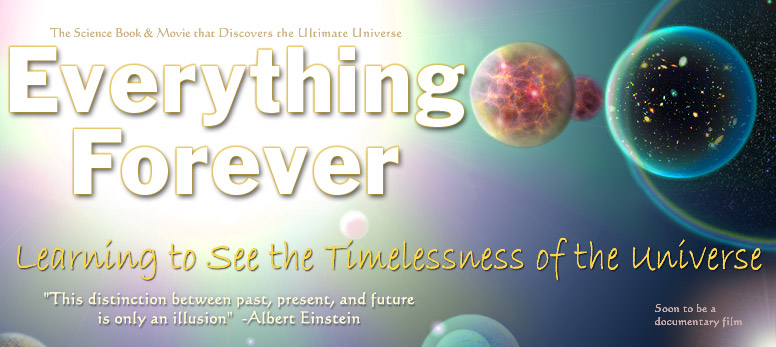



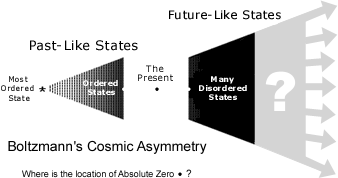

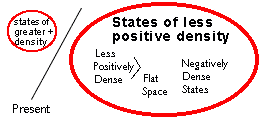





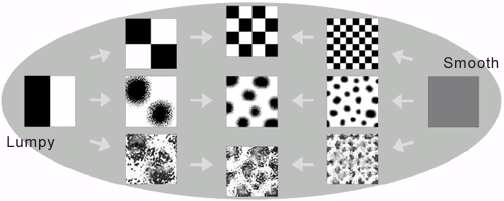


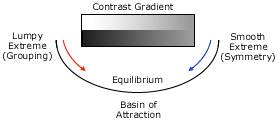 If the universe happens to move toward the lumpy side, the group of states which are more
smooth than the conditions of the universe naturally grows in size, the comparison might then be 60/40 percent greater
on the lumpy side, instead of 50/50 percent, and so the probability for conditions to turn back toward the smooth side,
toward the point of balance, grows ever stronger. The farther the system strays away from balance, in either direction
toward smooth or lumpy, the stronger the probability for that system grows toward turning back toward the more balanced
middle ground. And of course the same is true in the opposite direction toward increasing smoothness. The most
probable location in pattern space is always the point of balance between extremes. This creates what is called a
basin of attraction in between the extremes. That basin of attraction is made purely of directions of time flowing
between Alpha and Omega, which creates a well defined Many Worlds Partition.
If the universe happens to move toward the lumpy side, the group of states which are more
smooth than the conditions of the universe naturally grows in size, the comparison might then be 60/40 percent greater
on the lumpy side, instead of 50/50 percent, and so the probability for conditions to turn back toward the smooth side,
toward the point of balance, grows ever stronger. The farther the system strays away from balance, in either direction
toward smooth or lumpy, the stronger the probability for that system grows toward turning back toward the more balanced
middle ground. And of course the same is true in the opposite direction toward increasing smoothness. The most
probable location in pattern space is always the point of balance between extremes. This creates what is called a
basin of attraction in between the extremes. That basin of attraction is made purely of directions of time flowing
between Alpha and Omega, which creates a well defined Many Worlds Partition.